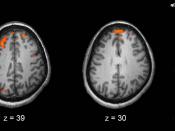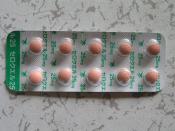Table of Contents
Introduction.............3
What Is Manic Depression?.............3
What is Schizophrenia?..................4
The Genetics of Manic Depression..........5
The Genetics of Schizophrenia.............. 6
Conclusion................8
Introduction
For years, it has been believed that mental disorders, such as manic depression and schizophrenia were caused by incidences that have occurred in one's past, complications when they were born, or through bad parenting. Recent evidence shows, however, that such disorders can be inherited through family members. In some ways, these mental disorders can be likened to cancer, in that there are both environmental and genetic factors that can cause one to contract the disease. This report shall focus on what manic depression and schizophrenia are and their genetic causes.
What Is Manic Depression?
Manic depression is when one experiences alternating periods of depression and mania. When one is in the depressive state, it can range from mild depression (or dysthymia, where one lacks a zest for life) to major depression.
A worst-case scenario could involve the patient experiencing lethargy, insomnia, excessive sleep, hopelessness, suicidal thoughts and attempts at suicide. When one is in the mania state, the patient could experience euphoria, delusions, pressured speech, increased activity and insomnia. The milder from of mania is called hypomania. Hypomania is characterized by the patient experiencing periods of elevated mood, irritability, racing thoughts, people-seeking, hyper sexuality, grandiose thinking, religiosity, and pressured speech Each state lasts for approximately two weeks. In some cases, both depressive and manic symptoms will be present at the same time. There are also three different types of bipolar disorder. The first one being bipolar I, in which the patient will experiences manic and depressive episodes as well as mixed ones. Bipolar II consists of major depressive episodes and hypomanic ones, and finally, cyclothymia, which consist of both dysthymic and hypomanic episodes. Although...



The Genetics of Manic Depression and Schizophrenia
This is an excellent essay. Very well written and helps the reader to understand these two diseases.
2 out of 2 people found this comment useful.